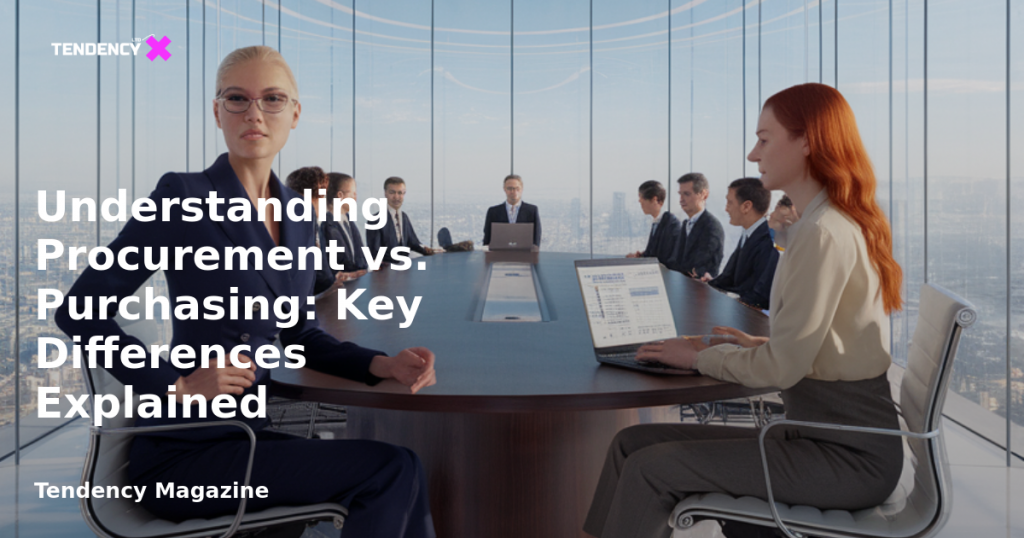Understanding Procurement vs. Purchasing: Key Differences Explained

Introduction to Procurement and Purchasing
In the fast-paced world of business, the acquisition of goods and services is a critical component that can greatly influence a company’s efficiency and success. Whether it’s sourcing custom merchandise for clients or acquiring essential software for operations, the way these acquisitions are managed plays a pivotal role. Understanding the nuances between procurement and purchasing is essential for businesses aiming to optimize their operations and maintain a competitive edge. Though often used interchangeably, procurement and purchasing are distinct processes, each with its own importance and impact on a business’s overall strategy.
Table of Contents
- Introduction to Procurement and Purchasing
- What is Procurement?
- What is Purchasing?
- Key Differences Between Procurement and Purchasing
- Conclusion
What is Procurement?
Procurement is a comprehensive, strategic approach to acquiring the necessary goods, services, and raw materials that a business needs to operate effectively. Unlike purchasing, which is transactional, procurement involves a broader scope of activities aimed at ensuring long-term operational needs are met. This includes researching potential suppliers, negotiating contracts, and building sustainable supply ecosystems.
Types of Procurement
There are three primary types of procurement that businesses typically engage in:
- Direct Procurement: This involves sourcing materials or items that directly contribute to the end product. For example, an eCommerce business selling phone accessories engages in direct procurement when sourcing phone cases or packaging materials from suppliers.
- Indirect Procurement: Indirect procurement involves acquiring goods necessary for business operations that do not directly contribute to the end product, such as office supplies or equipment.
- Services Procurement: This type involves hiring third-party providers for essential services needed by the business, such as logistics or IT support.
The Procurement Process
The procurement process is a multi-step approach designed to ensure efficient and strategic acquisition of goods and services. While the specifics may vary, the general steps include:
- Identify Business Needs: Assess and define what goods or services are required to address specific business challenges or goals.
- Create a Purchase Requisition Document: Develop a formal request outlining the purpose, budget, and timeline for the acquisition.
- Research Potential Partners: Identify and evaluate potential suppliers or service providers that can meet the business’s needs.
- Send Request for Quotation (RFQ) Documents: Solicit pricing and service details from potential partners through RFQs.
- Evaluate Options and Negotiate Rates: Choose the best partner based on factors such as cost, quality, and reliability, and negotiate favorable terms.
- Manage the Supply Chain: Ensure the timely and efficient delivery of goods or services through effective supply chain management.
- Build Ongoing Relationships with Suppliers: Foster strong, long-term relationships with suppliers to enhance reliability and potentially secure better terms.
What is Purchasing?
Purchasing is the specific process of acquiring goods or services, focusing on the immediate transaction between buyer and seller. It involves creating purchase orders, receiving shipments, and processing payments. While purchasing is a crucial component of procurement, it is more narrowly focused on the transactional elements.
The Purchasing Process
The purchasing process is relatively straightforward compared to procurement, consisting of the following steps:
- Create a Purchase Order (PO): Generate a document committing to the purchase, detailing payment terms, delivery dates, and other relevant information.
- Receive Goods or Services: Accept delivery of the ordered items or services.
- Verify the Order and Invoice: Ensure the accuracy of the order by matching the purchase order with the invoice and goods received note.
- Make a Payment: Process the payment to the supplier once the order is verified.
Key Differences Between Procurement and Purchasing
While purchasing is a subset of procurement, the two processes differ significantly in scope and focus. Purchasing is primarily concerned with the transactional aspects of acquiring goods and services, such as creating purchase orders and processing payments. Procurement, on the other hand, encompasses a broader range of strategic activities, including supplier research, contract negotiation, and supply chain management.
Not all acquisitions require the full procurement process. For instance, routine purchases like office supplies may be handled through simple purchasing, whereas significant or recurring expenses, such as raw materials for production, typically undergo the more comprehensive procurement process.
Conclusion
Understanding the differences between procurement and purchasing is vital for businesses looking to optimize their operations and maintain a competitive advantage. While purchasing focuses on the immediate transactional elements of acquiring goods and services, procurement involves a strategic approach to sourcing and managing long-term supplier relationships. By effectively balancing these processes, businesses can achieve greater efficiency, reduce costs, and enhance their overall operational success.
2025 Tendency LTD. All rights reserved.

